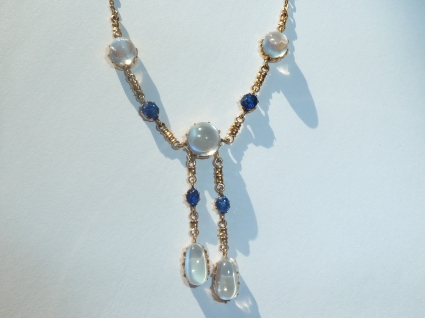
An extraordinary original Victorian half hoop ring with sapphires and diamonds, this one is from Richard Ogden
Good morning dearest, I hope you had a lovely weekend in the sunshine! Gosh this spring is really taking its time, and it has more than once made me think of a poem by the Swedish author Karin Boye:
Ja visst gör det ont när knoppar brister.
Varför skulle annars våren tveka?
Varför skulle all vår heta längtan
bindas i det frusna bitterbleka?
Höljet var ju knoppen hela vintern.
Vad är det för nytt, som tär och spränger?
Ja visst gör det ont när knoppar brister,
ont för det som växer
och det som stänger.
– Karin Boye
Yes, of course it hurts when buds are breaking.
Why else would the springtime falter?
Why would all our ardent longing
bind itself in frozen, bitter pallor?
After all, the bud was covered all the winter.
What new thing is it that bursts and wears?
Yes, of course it hurts when buds are breaking,
hurts for that which grows
and that which bars.
And now it is time to move over to jewellery! I have been showing my clients quite a few carved Victorian half hoop rings lately and thought that we should take a closer look today:

Victorian three stone half hoop ring in yellow gold at Richard Ogden

A side-view of the ring, with the carvings clearly visible

A collection of three stone half hoop rings at Richard Ogden – you can see how the designs vary, in everything from the cut or shape of the diamonds, to the width and design of the mounts
Victorian craftsmen started designing carved half hoop rings in the 1880s and they would either be worn as engagement rings or presented as gifts at the birth of a baby. The rings came with three, five or seven stones, and featured either all diamonds, or all rubies/sapphires/emeralds, or alternating diamonds and these coloured precious stones. Women would build up a nice collection of the rings, often with one in each colour: red, blue, green and white.

A beautiful sapphire and diamond ring, with little rose diamond points in between the larger gemstones

And a side view of the Victorian sapphire and diamond half hoop ring
Mr Alastair Norman from Harvey & Gore mentioned that today Victorian half hoop rings would make excellent engagement rings, as they sit perfectly next to a wedding ring. He also emphasised what wonderful quality coloured stones you can find in the early Victorian half hoop rings, the exquisite blue sapphire above here being the perfect example.
The rings would also feature little rose diamond points (in other words tiny diamonds in a rose cut) in between the bigger stones – you can see them in the photo above: tiny little fractions of a diamond at the foot of the sapphire and the diamond.

A Victorian-style half hoop ring with seven diamonds
The ring above belongs to one of my colleagues, Mrs C, who was kind enough to share it and its history with us today. It is a seven diamond Victorian-style carved half hoop ring (that is a mouthful!) that was given to her grandmother as an engagement ring circa 1918. It is quite rare to see a seven stone ring, and when her grandmother received it she was told by her fiancée that it represented Seven Days of Joy – how wonderful indeed!
Mrs C’s grandfather was a Master Baker on one of the merchant ships during the First World War. After the war he became a baker and quite a successful one, because at one point he was running three bakeries! Mrs C told me that the family lived in the bakery, and at one point the engagement ring went missing “as one of the members of staff had pinched it!” They managed to get it back though, and it was eventually passed down through generations, always to the youngest daughter in the family, which is why it now belongs to her.
And just for our curiosity: the single diamond ring that Mrs C is wearing in the photo above was her mother’s engagement ring, who got married in 1960. According to her mother and father the ring was brand new at that point, but we are both convinced that it is an older ring, because it features a beautiful old cut diamond in a 1920/30s setting.
I would love to hear your thoughts on this Victorian design; could you imagine wearing one of these as an engagement ring? What attracts you to it, and what doesn’t?




















































